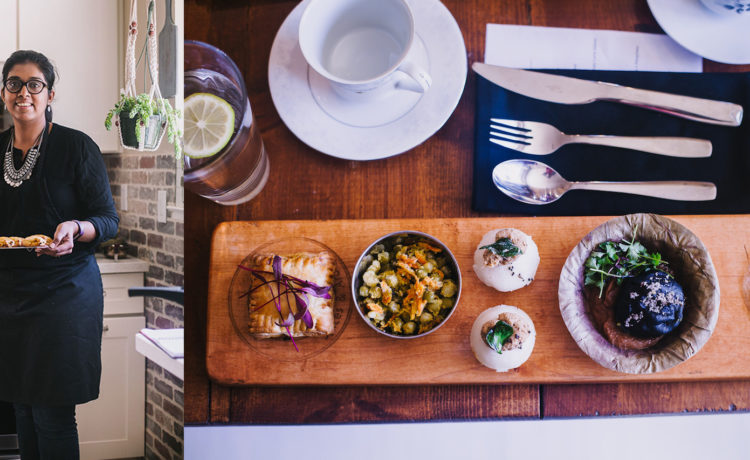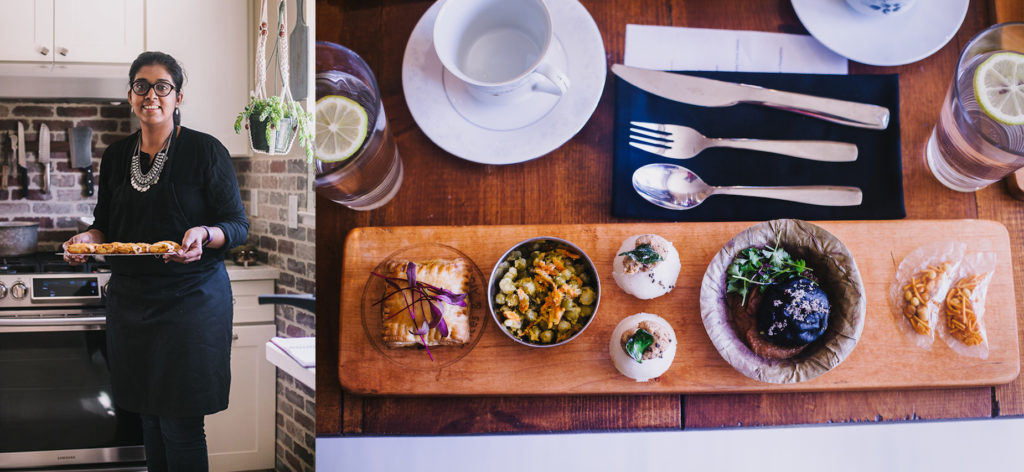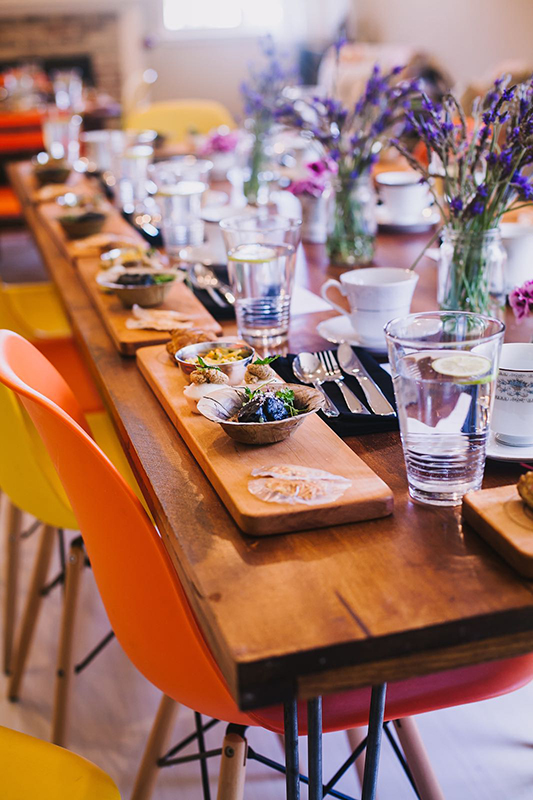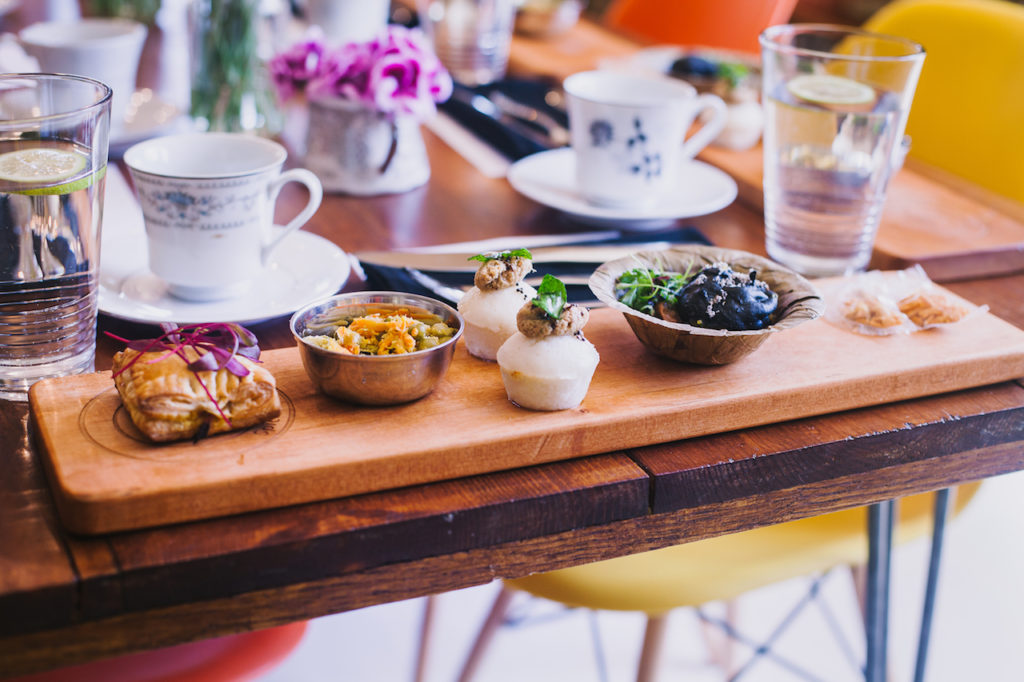

Vijitha Shyam is a molecular biologist, pop-up chef and mother of two who is excited to present her take on high tea featuring the flavors and ingredients of her home city of Chennai (formerly Madras) in South India. All images in this post courtesy of Kankana/Playful Cooking.
Read on to learn more about Vijitha’s story or get your tickets here to join us on July 1.

Tell us about the concept of “High Chai”: what inspired you and what can guests expect?
I first developed this concept two years ago as part of my Feastly pop-up series, Madras-83. It evokes the post-colonial legacy of the British high tea and combines it with authentic flavors and rituals from South India, where I grew up. In my memory, pausing for afternoon chai in India was a very special time for family and neighbors to gather and catch-up about their day. The door is always open, there’s no need for an appointment or invitation: it is an informal and casual gathering and that casualness is reflective of our culture of hospitality. I wanted to translate this special communal experience and replicate it in my current life in California, with a few innovations. In India we usually have chai with just a couple of snacks, before dinner. For this High Chai event I’ve planned a more substantial menu featuring an array of savory and sweet treats to showcase the diverse and rich culinary heritage of my home state of Tamil Nadu, one of the five states of Southern India.

What does cooking mean to you and how did you learn to cook?
I lived in India until I was 21 years old and back then I did not think much about cooking. When I moved to England for graduate school, I had an oven at home for the first time in my life, so I dedicated myself to baking! My mom joked that I never cooked for her but for everyone else. I would try my hand at veggie pies or the perfect banana bread. I received lots of positive feedback and encouragement from friends about my baking experiments. This support fuelled my motivation to stick with my passion for cooking throughout graduate school. I discovered how food could be a vehicle for storytelling, curiosity and intimate gatherings which is what continues to inspire me today.
In 2008 I started my food blog, Spices and Aroma, to document the culinary heritage of South India, and shortly after I moved to California in 2009 where I found myself immersed in its melting pot of food traditions from all over the world. Perhaps it’s due to my training in molecular medicine and my scientist mind-set that I tend to see the kitchen as a lab, where I can run my experiments mixing Indian flavors with California’s bounty of farm produce, and work at adding new dimensions to existing dishes.

What’s your secret for brewing the perfect chai?
Chai is very different from British-style tea like Earl Grey. (By the way, we never say ‘chai tea’, it is just chai!) We could define chai as “black tea latte with spices”. Milk is an essential ingredient, not just an accessory. Traditional Indian chai contains at least 50% milk.
In my chai I don’t overdo the spices, instead I prefer to focus on one type of spice (either cardamom, cinnamon or ginger – my favorite) and find the right balance of flavors. I include a dash of Ajwain seeds (what we call seeds are actually fruits of the Ajwain herb, used in India both as a cooking spice and as herbal tea for its health benefits) and boil it with black tea leaves and water. I then add the milk, bring the mixture to a boil and let it simmer for 15 minutes. This ‘double boil’ method draws out the flavors of the ingredients and allows them to slowly meld. It is a literal melting pot. Sometimes I don’t add sugar at all or I use Jaggery, an unrefined palm sugar that’s commonly used throughout India.
Can you share with us a highlight from the event menu?
I am excited to share a very special dessert, Gulab Jamun Cheesecake, which combines my favorite treat from South India, the traditional Gulab Jamun, with my newfound love for the American cheesecake that I discovered after moving here.
Gulab Jamuns are sweet dough balls filled with milk-solids and flavored with cardamom and rose water. They are one of the most popular desserts in India, an iconic item in every restaurant’s menu. When I moved to the US, I was trying the cheesecake everywhere I went, and it quickly became my favorite local sweet. I created the recipe I will present at the event to combine together these two traditions, in a perfect and delicate balance. It’s a mix that represents my life, enriched by two cultures that I love both equally. And I would particularly recommend to have this with the soave rose petal compote which will be served on the side.

Wow that is awesome